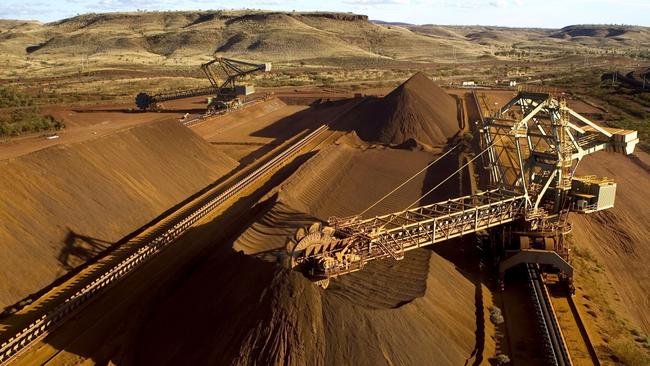Rio Tinto downgrades iron ore guidance again
Rio Tinto’s Pilbara production woes could linger into the second quarter, after fires and cyclones cut iron ore guidance.

Rio Tinto chief executive Jean-Sebastien Jacques’ “value over volume” mantra was writ large on the market, as the company’s shares surged to a decade-long high despite the miner issuing its second Pilbara production downgrade this month.
Mr Jacques’ favourite saying refers to Rio’s preference for quality products rather than tonnes delivered but it applied equally to the company’s share price today, as traders gave a rare warm welcome to a production downgrade.
Despite missing analyst expectations and again slashing its iron ore output guidance, Rio Tinto closed today at $101.20, up 45 cents. It hit a high of $102.83 in early trading, Rio’s highest mark since the global financial crisis shredded the value of mining stocks in 2008.
Rio said its Pilbara production problems could linger well into the second quarter of the year, as the iron ore giant cut up to another 5 million tonnes from its outlook as it struggles to recover from fires and tropical cyclones.
Rio said it now expected to produce 333 to 343 million tonnes of iron ore from its Pilbara mines, down from earlier guidance of 338 to 350 million tonnes. The combination of Cyclone Veronica and a fire at one of its Cape Lambert ore screening plants had already cost Rio 14 million tonnes from its likely output.
But Rio said its Pilbara cost guidance of $US13 to $US14 a tonne remained intact despite the setbacks and, with iron ore prices above $US95 a tonne and BHP and Fortescue Metals still to update the market on the cyclone’s impact on their own operations in the first quarter, investors continued their bets that rising commodity prices will more-than offset lost revenue from lower production.
Evans and Partners research analyst Andrew Hines told clients a $US10 a tonne rise in average iron ore prices could deliver Rio a $US2 billion boost to its free cash flow, opening up the prospect of further special dividends.
Macquarie Capital’s Grant Sporre said elevated spot prices for iron ore could list his estimate of Rio’s earnings by as much as 26 per cent if they were maintained.
And Rio said the disruption to its operations could linger for some time.
“Following further assessment, the damage to the port from Tropical Cyclone Veronica is expected to result in ongoing disruption to shipments,” the company said.
It said its recovery to full export rates in the current quarter “will remain subject to the weather.”
The iron ore major shipped 69.1 million tonnes of product from WA in the March quarter, below analyst expectations even given its earlier downgrades, and 14 per cent lower than the same time last year. Its mines produced 76 million tonnes of iron ore.
Cyclone Trevor, which swept across Queensland and the Northern Territory at the same time Cyclone Veronica was wreaking havoc on Western Australia, also cost Rio downtime at its Amrun, Weipa and Gove bauxite operations, although the company said its production was up slightly from last year, to 12.8 million tonnes, despite the disruptions.
Rio chief executive Jean-Sebastien Jacques said the operational performance of its other divisions was “solid”, with mined copper production up 3 per cent compared to the first quarter of 2018, to 144,000 tonnes.
But with production broadly flat, and Rio flagging further delays in the underground development of its flagship copper expansion at Oyu Tolgoi, renewed doubts are emerging over the growth outlook for the mining giant.
Mr Hines told clients Rio’s growth pipeline would be a key issue for the company this year.
“Apart from iron ore, production guidance for 2019 is unchanged — everything is flat or declining except bauxite volumes,” he said.
“The focus in the past three years has been on asset divestment, balance sheet repair and cash returns to shareholders. Investors will be asking ‘what is next for Rio?’,” he said.

